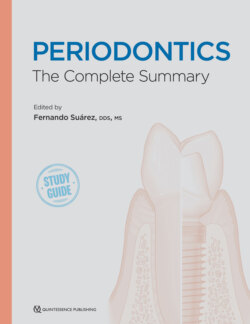Читать книгу Periodontics - Fernando Suarez - Страница 35
На сайте Литреса книга снята с продажи.
Advanced and Emerging Examination
ОглавлениеPeriodontitis is a multifactorial disease involving the combination of dysbiosis of oral bacteria and an overreacted immune response from the host.33 One of the disadvantages of the clinical periodontal evaluation is that these examinations only record destruction that has already occurred, such as the bone loss pattern and periodontal pockets. Therefore, patients would greatly benefit from techniques that detect the development of periodontal inflammation before tissue breakdown occurs and prevent further complications such as bone loss, tooth mobility, and ultimately tooth loss. The major rationale to develop advanced methods for examination is to detect disease activity at a subclinical level in order to provide early diagnosis and create a treatment plan tailored to each individual.34
Researchers and scientists have been investigating possible periodontitis-related biomarkers that could be used to distinguish between healthy and diseased patients.34 These biomarkers can be collected from saliva, which can demonstrate overall periodontal health at a subject level, or gingival crevicular fluid, which is site specific.34 For instance, proportions of specific periodontal pathogens, pro- and anti-inflammatory cytokines, and tissue-degradation products have all been studied to differentiate between healthy and periodontitis subjects. Among all biomarkers, interleukin-1 (IL-1) is one of the most notable proinflammatory cytokines that has been extensively studied in the periodontal field.34,35 Periodontal pathogens that have been extensively studied and proved to be closely linked to the development of periodontitis include Porphyromonas gingivalis, Treponema denticola, Tannerella forsythia, Aggregatibacter actinomycetemcomitans, Fusobacterium nucleatum, and more.2,36 Research in the field of advanced examination and biomarkers is still ongoing, and the results have indicated a promising future for early detection of periodontitis. However, these examinations are still not routinely utilized, due at least in part to the additional costs and disassociation to treatment options (ie, the test results would not alter the treatment plan).34
